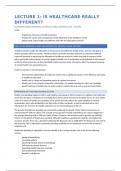Summary
Samenvatting - Economics and Financing of Health care systems (GW4567M)
- Course
- Institution
Summary of economics and financing of health and health care, block 1 of HEPL master, full description of all principles and theories needed for the exam
[Show more]





